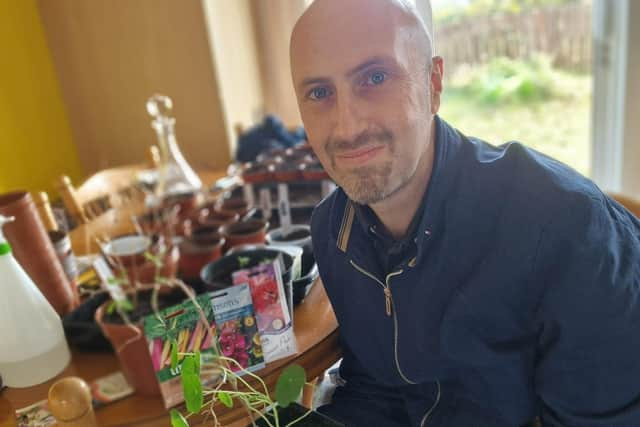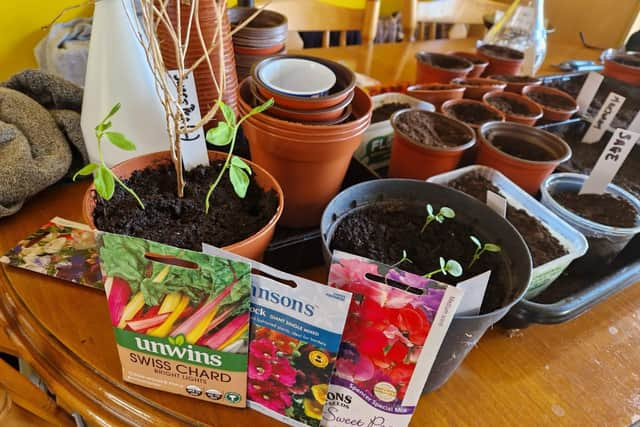Gone to Seed: Gardening with Brendan Week 1 - Introduction and what I am planning to sow in 2024
and live on Freeview channel 276
I’ve been gardening for a few years on off but usually play it safe with the same shop bought seedlings. This year I thought I’d branch out a bit and try growing different types of plants including herbs, a few different vegetables and a lot of different flowers from scratch.
Growing from seed, according to the experts, is a learning curve and there is no guarantee of success, so we will see what does OK and what doesn’t, and I’ll share what I know and what I’ve learned along the way, and some handy tips for beginners.
Advertisement
Hide AdAdvertisement
Hide AdIt’s now heading into the second half of March and in this part of the world in north west Ireland we are in gardening zone 9b so it is still too cold for most plants to be left outside. As a result, my kitchen has the makings of a Little Shop of Horrors and I don’t have a greenhouse or shed set up yet. It will be another six weeks before the last frosts have passed here so I’m hoping to have a clean kitchen again by the start of May.


So what am I growing? I started in around mid-February with calendula, also known as pot marigold, which produce masses of bright orange and yellow daisy-like flowers. They have germinated just fine and most have been transplanted to single small pots from the seed tray now. They are still very small and probably in need of some heat to bring them on but they look healthy enough.
Other flower seeds I planted last month include sweet pea, larkspur and night scented phlox, which according to the packet they came in smell a lot like sweets (candy) when the flowers open in the summer evening. The phlox seeds have all germinated and have their second or ‘true’ leaves now so I’ll be transplanting those soon. Did you know that the first set of seeds are called ‘cotyledons’ and are part of the seed itself, while the second set of leaves to emerge, the ‘true leaves’ are the ones which show the true foliage of the plant? There are also some mystery seeds I had in a little bag and they are up through the soil, thought they are tiny. As well as those, a few Forget-Me-Nots have germinated, as have four sweet pea, while the rest of the latter didn’t make it as I put them in the hot press (airing cupboard) not realising they prefer cooler conditions, so most rotted in the heat. I have more sweet pea and some hollyhock that I plan to sow next week and I’ll do a little video and update on that then.
Since March started I’ve planted a whole lot more seeds, including tomatoes and a lot of herbs such as oregano, dill, basil, chives, garlic chives (yes they are a thing apparently) but those seeds are pretty old so I’m not expecting great things. I also have some French marigolds, trailing lobelia, baby’s breath and Swiss giant pansies in trays and am hoping at least some of them will pop up.
Advertisement
Hide AdAdvertisement
Hide AdWhen it comes to germination, the conditions necessary for the seeds to sprout vary widely. At the moment I also have petunias and lobelias on the window sill by day and in a warm room by night as they need both heat and light to germinate, while the lupin seeds are under the kitchen table as they need cooler temperatures of 10-15 degrees Celsius (50 to 59F) and the pansies are in the hot press as they need darkness and warmth to germinate.


Some plants also need special pre-treatment. I’m trying cold stratifying for the first time and I have lavender seeds in the fridge at the moment and will do a little demonstration and explain how I did that in the next video and on the blog post here. I’m trying the same process with some rosemary and some sunflower seeds so we’ll see how they go.
Failures so far in terms of germination have included sweet william, dahlias and brussel sprouts as well as a big damson seed which has just sat there in the soil for over a month doing nothing. Did I mention you need patience when gardening? Some plants will germinate within a few days, but others can take several weeks. Again, patience.
I plan to direct sow some vegetable seeds, rose and red poppies, cornflowers and nigella (love in the mist) later in the spring, when I work up the energy to tackle a big patch of the garden which the grass has reclaimed over recent years.
Advertisement
Hide AdAdvertisement
Hide AdThis week I’ve also prepared some pots, where a lot of these seedlings will end up, by sticking copper tape, which I had bought for some stained glass craft work, around the rims. I did this last summer with some shop bought young plants which I potted on as I read somewhere that copper can act as a barrier against the gardener’s main adversary, slugs and snails, and it worked very well in most instances. It seems the slugs and snails won’t cross the copper and will turn on their slime trails and head back from the underworld from whence they came. Trying to prevent them from eating your carefully raised young plants in the ground is a much more difficult challenge if, like me, you don’t want to kill them. I’ve read of a few different techniques and plan to try those out later on.
Time to get the trowel out... ‘til next week.